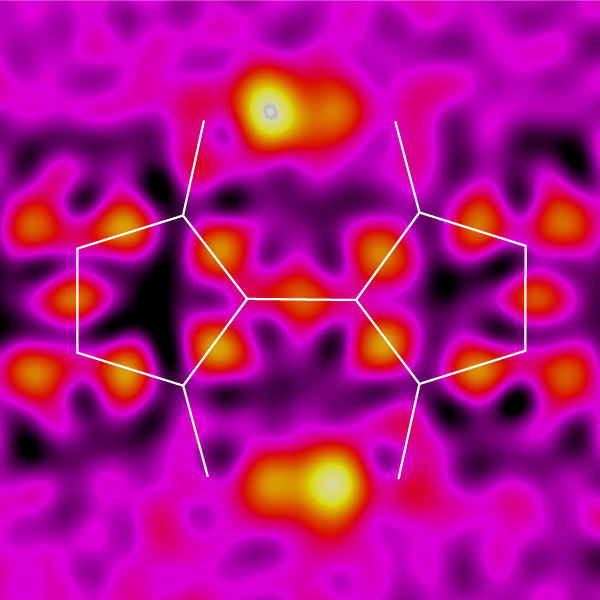Feb. 1, 2024 Research Highlight Chemistry
Organic semiconductors with proton-hopping promise
A new method for making molecules derived from an ancient organic dye could inspire future flexible electronic devices

Figure 1: Single-crystal x-ray analysis captures the two protons (bright yellow spots, top and bottom) moving between two positions on the molecule. Reproduced from Ref. 1 with permission from the Royal Society of Chemistry and licensed under CC BY 3.0 DEED
Chemists at RIKEN have developed a method for making synthetic derivatives of the natural dye indigo that doesn’t require harsh conditions. This discovery could inspire advances in electronic devices, including light-responsive gadgets and stretchy biomedical sensors1.
Semiconductors based on organic molecules are attracting much interest because—unlike conventional rigid semiconductors based on silicon—they could be flexible, ductile and lightweight, opening up new possibilities for designing semiconductor devices.
Organic molecules also have the advantage of realizing a broad range of structures. “Organic semiconductors have flexibility in molecular design, enabling them to adopt new functionalities,” says Keisuke Tajima of the RIKEN Center for Emergent Matter Science, who led the research.
To explore this potential for enhanced electronic function through molecular design, Tajima and his team investigated a molecule related to indigo, called 3,3-dihydroxy-2,2-biindan-1,1-dione (BIT). “This project started with a simple question: can protons and electrons move in concert in the solid state?” says Tajima.
Proton-coupled electron transfer—in which the motion of electrons is linked to that of protons—is often considered critical for realizing efficient electron transfer in biological systems. If it can be incorporated in organic solid-state materials, it could lead to semiconductors with unique dynamic properties. Until now, however, no solid-state material displaying proton-coupled electron transfer has been demonstrated.
Tajima and his team have now found that BIT and its derivatives undergo unusual rearrangements in their structures involving double-proton transfer, which may lend them unique capabilities as electronic functional materials.
Tajima identified BIT and its derivatives as promising materials for solid-state proton-coupled electron transfer, because the molecule incorporates two protons that appear ideally positioned to hop from one position to another during electron transfer.
Until now, making BIT required harsh conditions that severely restricted the range of derivatives that could be made. Members of the team developed a room-temperature approach that enabled the synthesis of several BIT derivatives under much milder conditions.
With BIT derivatives in hand, the team explored the molecules’ properties. “The most difficult part was to prove that the protons in BIT undergo proton transfer between molecules in the solid state,” says Tajima. In collaboration with RIKEN experts in x-ray crystallography and solid-state nuclear magnetic resonance (NMR), the team demonstrated that the two protons do rapidly exchange their positions.
Calculations suggest that proton transfer is indeed coupled with charge transport; the team’s next target is to confirm this coupling experimentally. “We don’t know if the presence of a proton will enhance charge transport, but as fundamental physics it could open interesting avenues,” says Tajima.
Related contents
- Molecular tweak boosts performance of organic semiconductors for flexible electronic devices
- Bringing fullerene closer to semiconducting polymer boosts the efficiency of organic solar cells
Rate this article
Reference
- 1. Nakano, K., Leong, I. W., Hashizume, D., Bulgarevich, K., Takimiya, K., Nishiyama, Y., Yamazaki, T. & Tajima, K. Synthesis of 3,3 -dihydroxy-2,2 -diindan-1,1 -dione derivatives for tautomeric organic semiconductors exhibiting intramolecular double proton transfer. Chemical Science 14, 12205 (2023). doi: 10.1039/d3sc04125e
